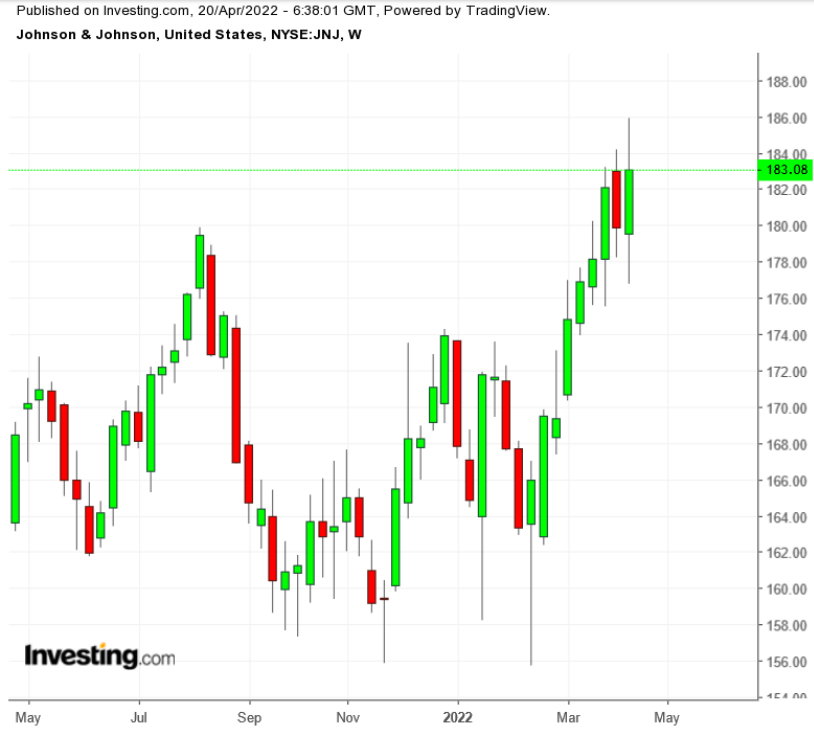There's a simple, enduring case for Johnson & Johnson (NYSE:JNJ) stock. Globally, people are living longer and getting more and better access to healthcare. That trend is going to continue—and it should provide a steady, consistent tailwind to J&J revenue and profits.
Admittedly, that case might sound not just simple, but simplistic. But bear in mind that global healthcare spending in 2022 is estimated to be in the range of $10 trillion. After reporting first quarter earnings on Tuesday, Johnson & Johnson is guiding for 2022 revenue just shy of $100 billion.
Even excluding the contribution from the company's Consumer Health business—which includes non-medical products like shampoo and baby powder, and is being spun off—J&J is on the other end of something like 0.8% of the world's annual medical spend.
J&J revenue and profits will continue to rise as long as that spend continues to grow and as long as the company continues to execute. This week's first quarter earnings report should give investors confidence on both fronts.

And even at an all-time closing high, shares finished on Tuesday at $183.08, JNJ stock remains easily cheap enough for that confidence to drive further upside from here.
A Wonderful Business
There's likely little argument that Johnson & Johnson is one of the world's great businesses. It bears repeating: the company generates roughly 0.8% of the world's entire healthcare spend.
It's a staggering sum due in part to the company's global reach. Per the company's annual report filed with the U.S. Securities and Exchange Commission, J&J operates in “virtually all countries of the world.” In 2021, nearly half of its revenue came from outside the U.S.
The company's medical devices business, now known as the MedTech segment, generated nearly $28 billion in revenue last year. That's second worldwide only to Medtronic (NYSE:MDT).
Its pharmaceutical business is the sixth largest globally, ahead of leaders like Pfizer (NYSE:PFE) and Bristol Myers Squibb (NYSE:BMY).
Q1 numbers highlight both the strength and breadth of J&J franchises. Geographically, U.S. adjusted operational revenue (which excludes acquisitions, divestitures, and foreign exchange effects) increased 2.8%. Overseas revenue grew 13%. Obviously, a return to post-pandemic normalcy helped, but despite a stronger dollar, reported revenue increased 17% over 2019 levels—an annualized growth rate over 5%.
Plus, it was the two core medical businesses that did the heavy lifting in Q1. Pharmaceutical revenue increased 9.3% on that adjusted operational basis, and MedTech 8.6%. On the first quarter conference call, management provided a strong outlook for the full year as well.
MedTech revenue should benefit from both a market recovery and growth from new product launches. Pharmaceutical sales are expected to grow at an above-market rate, even with lower-than-expected revenue from the company's COVID-19 vaccine.
The Market Gets Its Focus Back
All told, Q1 offers more evidence for the strength of J&J's business. To be sure, that strength has been there all along. For example, management on the Q1 call noted that 2022 should be the 11th consecutive year that the Pharmaceuticals business has grown faster than the global market.
But investors did lose focus on the underlying business amid a number of one-time issues. Potential liabilities from J&J's opioid products clearly pressured JNJ stock. But J&J now has largely settled its cases for costs that are exceptionally manageable against the current $480 billion market capitalization.
Class-action lawsuits over J&J baby powder also spooked investors. But a legal maneuver should minimize any liabilities on still-pending lawsuits.
Even the COVID-19 vaccine has affected JNJ stock at times. Shares fell 3% premarket a year ago when the J&J vaccine was paused on the recommendation of the US Food and Drug Administration after cases of a rare type of blood clot were reported after six individuals received the vaccine—even though the company was selling the inoculation essentially at cost.
Simply put, there's been a lot of noise around JNJ stock over the past few years. And there were too many investors listening to that noise. But at this point, that noise is largely gone—a key reason why JNJ stock has rallied.
The Long-Term Case for JNJ Stock
Even after the robust earnings, there's still potentially more upside. After all, it's not as if JNJ stock is expensive. Shares trade at just 17.4x the midpoint of adjusted earnings per share guidance for this year.
That's hardly an expensive multiple, even in a broad market that has pulled back from its highs. With the company announcing a 6.6% dividend hike on Tuesday as well, shares now yield a healthy 2.47%.
That yield plus organic earnings growth alone can drive high-single-digit annualized returns. Given the defensive nature of the product portfolio—the business isn't quite recession-proof, but it's about as close as an investor can get—those returns alone seem more than attractive.
Still, there's another lever to pull here as well. J&J has an exceptionally clean balance sheet. Johnson & Johnson closed the first quarter with $33 billion in debt—and $30 billion in cash. With legal liabilities now largely known, the company can ramp up share repurchases, which in turn will amplify EPS growth—and shareholder returns.
Granted, it's not the sexiest bull case in the market, certainly. More aggressive investors might look to growth stocks that have sold off sharply in recent months.
But investors of any stripe can still look to JNJ stock as a core holding. This is a wonderful business at a solid valuation. At the end of the day, that's precisely the combination investors should be looking for.
